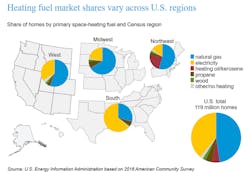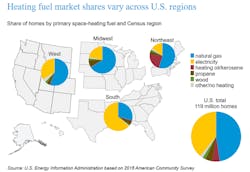EIA forecasts higher US home heating bills this winter
Expected colder weather and higher energy costs will raise average household expenditures for all major home heating fuels from October through March, the US Energy Information Administration said in its latest Winter Fuels Outlook. Average increases vary by fuel, with bills for home heating oil forecast to grow by 17%, natural gas by 12%, electricity by 8%, and propane by 18%, it said on Oct. 11.
Temperatures across the US are expected to be 13% colder than last winter, which was much warmer than normal, with year-to-year swings ranging from 27% in the South to 4% in the West, EIA said. Despite the expectation that temperatures in the East will be colder than a year earlier, they are projected to be comparable to the average of the past five winters, while those in the West are expected to be about 7% colder, it said.
Costs for natural gas, which EIA said heats nearly half of all US households, are expected to increase year-to-year by $69, or 12%, driven by a 9% growth in consumption and 2% higher prices. Henry Hub spot prices are expected to average $3.30/Mcf this winter, which is 5% higher a year earlier. EIA projects gas inventories will total 3.8 tcf at the end of October, based on expected injection rates.
It said it expects households heating primarily with heating oil to spend an average of $215, or 17%, more this winter than last winter, reflecting retail prices that are 25¢/gal, or 10% more, and consumption that is 6% higher than last winter. “Despite the higher forecast expenditures, expected average household heating expenditures this winter are about 15% lower than the previous 5-year winter average,” EIA noted.
US refinery runs fell because of Hurricane Harvey, but are expected to increase in the coming months and to be higher than last winter, it said. High distillate fuel levels at refineries have the potential to moderate prices somewhat, and strong distillate margins could encourage refiners to maximize distillate production, EIA said.
“However, if temperatures become severely cold, the Northeast typically turns to imports for distillate fuel supply, and prices have the potential to rise above forecast levels. Higher prices encourage imports to be shipped to the region,” it said. “If a cold snap in the US Northeast coincides with a cold snap in Europe, the main source of US imports, additional upward pressure on distillate prices might occur.”
It said that households heating primarily with electricity are forecast to spend an average of $74, or 8%, more this winter on their power bills. The increased expenditures are a result of 6% higher consumption, including both heating and non-heating uses of electricity, and about 2% higher residential power prices than last winter. Among US households, 40% rely on electricity as their primary heating source. Nearly two-thirds of homes in the South heat primarily with electricity, compared with only 16% in the Northeast, EIA said.
Contact Nick Snow at [email protected].
About the Author

Nick Snow
NICK SNOW covered oil and gas in Washington for more than 30 years. He worked in several capacities for The Oil Daily and was founding editor of Petroleum Finance Week before joining OGJ as its Washington correspondent in September 2005 and becoming its full-time Washington editor in October 2007. He retired from OGJ in January 2020.

